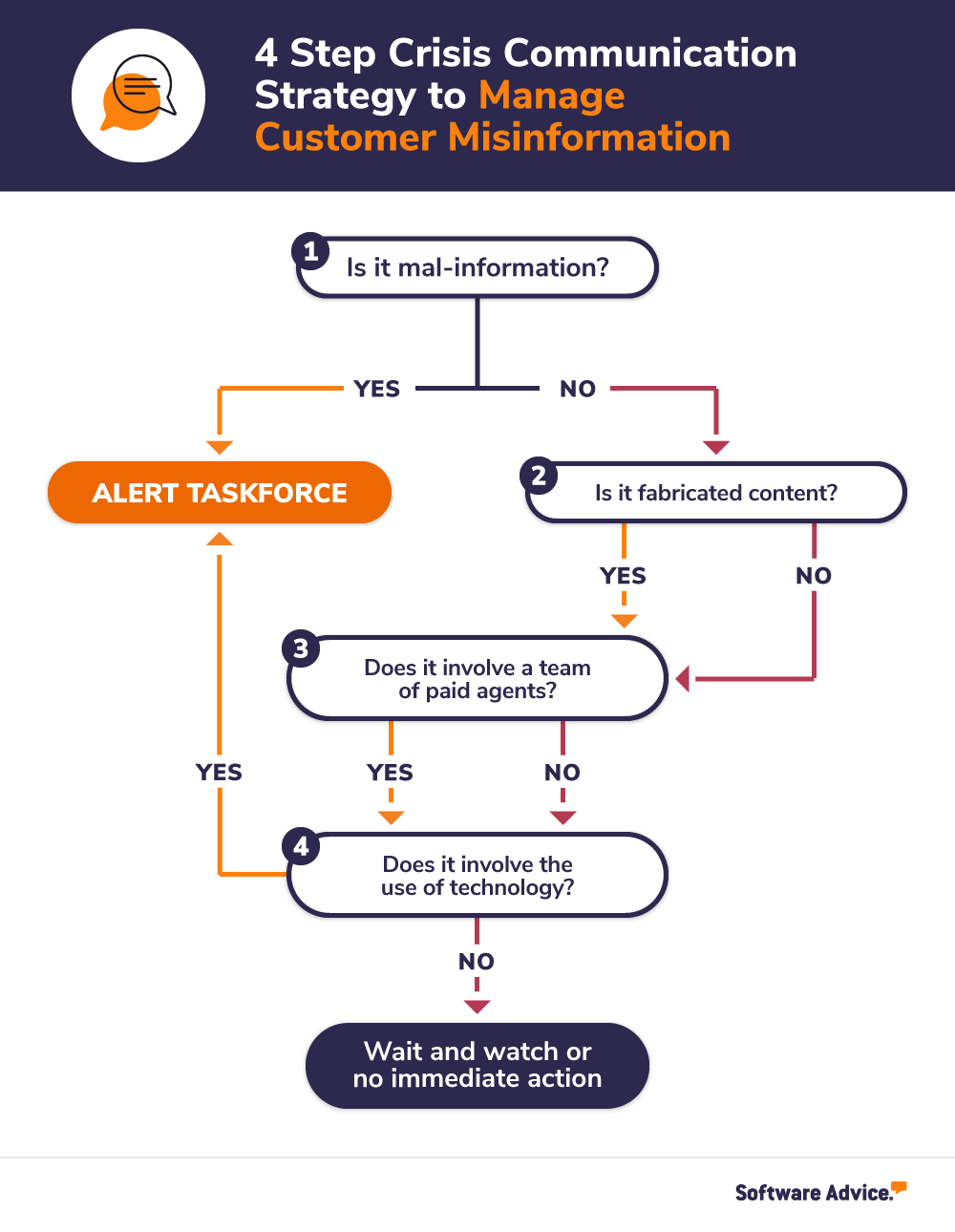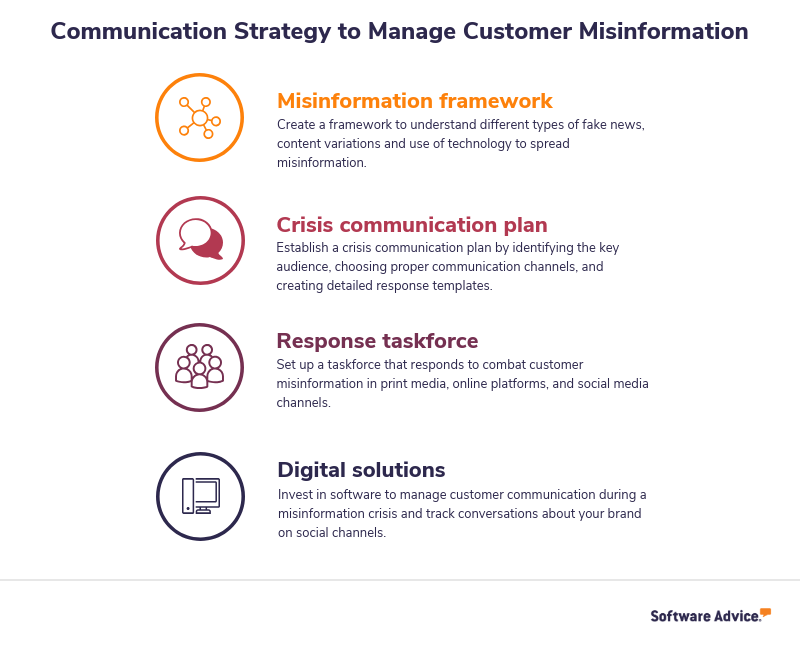4 Step Crisis Communication Strategy to Manage Customer Misinformation
There are viruses that can crash your computer, and there are viruses that can make you sick. Each category is completely different and neither targets the victims of the other.
But some people in the U.K. presumed there was an overlap and decided to burn 5G towers as their contribution to combating the coronavirus pandemic!
Sounds ludicrous, but it’s every bit true—and perfectly highlights how misinformation can cost a business substantial losses in a matter of no time.
A study on fake news conducted by the North Carolina State University reveals that “fake news inspires consumers to demand corrective action from companies, even if the company is a victim of the fake news story.”
To safeguard themselves against misinformation, businesses need to devise crisis communication strategies. This involves creating a framework for understanding and classifying customer misinformation, setting up a task force to respond to the crisis, and establishing procedures for effective communication with customers.
In this piece, we’ll look at a four-step crisis communication strategy that will help you understand, identify, and respond to customer misinformation.
Here’s what we’ll cover:
Step 1. Create a framework to understand misinformation
Step 2. Establish a crisis communication plan
Step 3. Set up a response task force
Step 4. Stay ahead of misinformation with digital solutions
Step 1. Create a framework to understand misinformation
Creating a framework to manage misinformation requires your organization to first understand the different types of fake news, variations in content, the agents, and technology.
Not every kind of misinformation should send your organization clamoring for action. For instance, satirical news widely shared in social media could be harmless and only intend to be ironic. These aren’t essentially fake news and you should be cognizant of this nuance when creating the framework.
To help you get started, we have created this framework for understanding, identifying, and responding to misinformation.

If you have 2 or more “Yeses” then you should consider alerting the task force. However, a single “Yes” (impostor/fabricated content that is not mal-information, doesn’t have a team behind it, and doesn’t use specialized technology) can be kept on a close watch without any immediate action.
Identify the type of information disorder
A UNESCO report classifies the malaise of fake news as information disorder. Understanding the underlying distinctions helps in effectively responding to each.
Misinformation: The person/team spreading the news doesn’t know it’s false.
Disinformation: The person/team knows the news is false but still spreads it.
Mal-information: The person/team has intentionally created and spread the false news with the intent to harm.
Analyze the content
Internet and social media platforms are ripe with different kinds of fake content produced by roguish individuals (internet trolls) or paid groups (fake influencers and black PR firms). Factoring this aspect helps you gauge how the misinformation can be viewed by your customers.
Analyzing the content is crucial to understanding the impact it can have on your business. Tagging content to relevant categories is a key requirement here.
Click-bait: With the growth of content marketing and native/paid advertising, this content has become quite popular. Click-bait includes images and captions designed to attract the audience; they aren’t typically fake news but rather misleading content that is usually harmless.
False context: This content, as such, is genuine but is taken out of its original context. Typical examples are old videos and images shared by internet trolls on online forums, social channels, and communities, which go viral when falsely attached to an unrelated context. While such content is generally created for amusement, businesses should watch out for false context in negative online reviews about their products and services.
Impostor content: This includes unauthorized and illegal use of an organization’s logo, branding, or similar assets on certain information, which may or may not be fake. Such content can be a real threat for businesses if it’s backed by a team of agents paid to work on fake news and smear campaigns.
Fabricated content: This content can include doctored images, deep fakes, fake company information, and other propaganda. Such content can severely damage the reputation of a business. Typically, it’s created by black PR firms using a combination of technologies (from specialized automation software to bots and artificial intelligence) and spread via several bogus social media accounts.
Decipher the use of technology
Compounding the bane of fake blogs and social messages is the use of emerging technologies to amplify the spread of misinformation. Understanding the use of technology is crucial for taking effective measures to curb misinformation.
Bots: These are automated computer programs that can conduct fake news campaigns. Bots are very difficult to spot and can create content (by curating images and sourcing news online) as well as spread it (by having online conversations) on social channels.
Deep fakes: It’s an example of AI-powered deep learning technology that involves facial reanimation and voice impersonation. The program uses machine learning to mimic facial expressions and can be taught to impersonate voice by voice-over artists.
Step 2. Establish a crisis communication plan
Along with a framework to understand misinformation, what you need is a crisis communication plan. This requires you to check for updated information on your customers, choose proper communication channels, and create detailed response templates.
Identify with whom and how you communicate
To curb the spread of misinformation, it’s necessary to figure out the key audience and determine the channels of communication.
Key audience: Identify the key audience you’ll want to communicate with first, such as your big-ticket customers and shareholders. This list will differ according to the type of misinformation and can go on to include business partners, suppliers, and related networks.
Communication channels: There are various modes of communication—emails, print media, television, etc.—you could be using concurrently. However, the right choice is the platform preferred or most widely used by your desired audience.
Develop effective crisis response statements
During a misinformation crisis, you need to respond quickly and ensure that responses are factual and impactful. To make your responses effective, you need to pay attention to how you craft response statements.
Proactive statement: This statement is released quickly to counter misinformation. It’s crafted using publicly accessible information on your company web pages, press releases, social media channels, Wikipedia page, and marketing publications. You need to ensure that the facts in a proactive statement are up-to-date and accurate.
Hold statement: This statement is used when you don’t have the time to examine the facts but need to respond immediately, typically within an hour of the incident. It needs to answer the classic 5Ws and 1H questions (who, what, when, where, why, and how).
Reactive statement: This statement is released after you’ve conducted the investigation and established the facts. It needs careful consideration as it should relieve customers and the rest of the audience of any doubts. It must be well-rehearsed before made public and preferably delivered by a skilled spokesperson from your organization’s crisis communication task force.
Step 3. Set up a response task force
To successfully implement a framework and crisis communication plan, you need a task force that constantly monitors online channels for instances of fakes news and has a response plan ready for handling misinformation.
The task force should comprise representatives from different departments and their roles and responsibilities need to be clearly laid out.
Executive leadership and departmental heads
The executive leadership, such as the CEO and vice presidents, are always informed about crises. They:
Stay informed and updated during times of crisis to offer guidance.
Get involved in creating and reviewing policies for the right course of action.
Select the team leader/leaders for the crisis communication task force.
Core team
This is the team that executes the key tasks, such as preparing the crisis communication strategy and responding to inquiries from clients and media agencies.
Core team members | Responsibilities |
Team leader/leaders | • Report to the leadership for status updates. |
Branding and PR team members | • Determine the timing and channels for releasing the response statements. |
Spokesperson | • Communicate authoritatively and clearly on internal and external media channels. |
Marketing team analysts | • Use fact-checking tools for validating the authenticity of the content. |
Additional team members
Besides the core members, businesses can have add-on members depending on the scale and severity of the crisis. Below are two examples of add-on team members:
Ombudsman officers and lawyers
This team investigates the legal impact of the misinformation and lays down communication protocols. Their chief responsibilities in the task force can be:
Preparing guidelines on how the organization can defend itself from fake news.
Examining the legal impact of complaints and claims against the business.
IT team members
This team analyzes the use of technology in spreading misinformation and devises methods for identifying fake news. Their chief responsibilities in the task force can be:
Identifying the technologies, such as deep fakes and bots, used to spread misinformation.
Detect misinformation scams and execute security measures to protect customers/stakeholders from potential threats.
Step 4. Stay ahead of misinformation with digital solutions
You should also invest in software to manage communication during a misinformation crisis, safeguard your company’s reputation, and improve brand recognition.
Customer communication tools
These tools help you in communicating with customers and informing them of the facts to curb the spread of misinformation.
Email marketing software: The software allows you to send emails to several recipients simultaneously. The tool can help in sending targeted emails to inform customers of the facts and the action you’ve taken to combat misinformation.
Community software: The software is used to build native online communities that serve as discussion forums for customers. The tool allows customers to ask questions and find answers about your organization’s services and products and can be a useful platform for broadcasting official statements during a misinformation crisis.
Live chat software: The solution allows customers to resolve their queries over an online chat with customer support representatives. It can serve as a direct channel for your customers to reach you for resolving their doubts during a misinformation crisis.
Communication monitoring tools
These tools offer detailed reports for tracking conversations about your organization on online platforms and social channels.
Social media analytics software: The software helps you monitor and understand your brand’s overall presence on social media channels, while monitoring specific conversations, around your brand name, to identify instances of misinformation.
Reputation management software: This is a specialized solution that helps you track customer reviews on third-party websites. Using the software, you can identify and respond to any fake reviews. Additionally, the software allows you to create email campaigns for gathering reviews from customers.
Conclusion and next steps
This report includes the proactive steps you need to take for creating an effective crisis communication strategy. Here’s a quick summary of the steps:

Further, do an inventory of the communication tools your company is currently using. Are all of them up-to-date and capable of tracking customer communication across multiple channels?
For guided assistance, on the right communication tools for your business, fill out this form for a free consultation with our software experts.